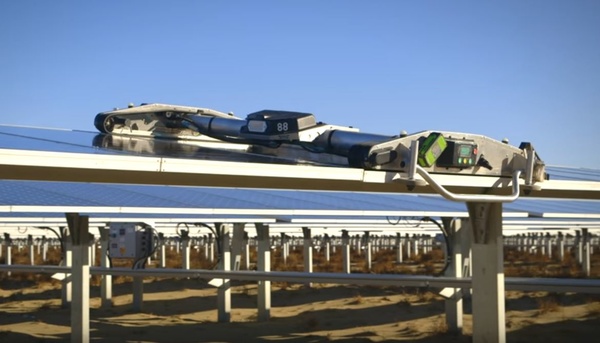|
stanford university has made it a priority to cut its dependence on fossil fuels with an innovative energy system that relies on renewable resources and a first-of-its-kind campus heat recovery system. stanford energy system innovation (sesi) is a commitment by the university to cut greenhouse gas emissions by 68 percent, its use of fossil fuels by 65 percent, and total campus water use by 15 percent.

a robot cleans solar cells at sun power's array that will be used by stanford university. (youtube)
stanford president john hennessey told the school’s website, "sesi achieves a stunning and unprecedented reduction in stanford's carbon footprint and water usage. we believe this system can be a model for others equally concerned about reducing greenhouse gas emissions and willing to make an investment in the future. sesi is a transformational energy system for the 21st century, and we look forward to sharing the technology with others."
in march, stanford announced that the university would be purchasing the majority of campus electricity from renewable sources within california. in december, this promise came to fruition when solar energy company sun power completed five months of construction on a 67-megawatt plant in the mojave desert.
the solar plant includes nearly 19.9 million solar cells and covers 200 acres. the solar panels turn towards the sun to increase efficiency and they are covered with dampeners to avoid damage from high winds and to keep the panels cool.
at the presentation to celebrate the end of construction, sun power demonstrated the new robots it created to clean the solar panels. the robots use less than half a cup of water per panel and have been show3n to increase efficiency by as much as 15 percent.
stanford is not directly connected to the solar array, but it will purchase all of the electricity that it produces at a fixed price for the next 25 years. according to an article on the stanford website, the price is about 20 percent lower than expected.
in addition to the solar power, stanford has also looked to cut energy costs by replacing 22 miles of pipes and rehabbing 155 buildings on campus to recycle waste heat. the central energy facility (cef) captures two-thirds of campus waste heat from the cooling system and produces hot water for the heating system.
the article continued, “the software has the ability to predict hourly campus heating, cooling and grid electricity prices 10 days in advance and then determine when it is most economical to use electricity to operate plant heating and cooling equipment. it also will determine how much hot and cold water to store in the cef's water thermal storage tanks for later use. it is designed to meet the school’s energy needs all the way through 2050.
"by significantly reducing natural gas usage and electrifying the campus heating and cooling system, we enabled the university's energy supply to be substantially transitioned from fossil fuels with volatile and unpredictable long-term prices to clean renewable electricity sources with affordable costs fixed for a very long time," said joseph stagner, executive director of sustainability and energy management at stanford, on the school’s website.
learn more about the new solar array in the video below:
|